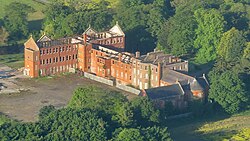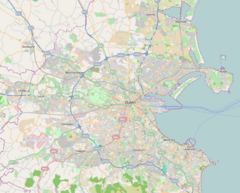Belcamp House
| Belcamp House | |
|---|---|
 Belcamp House in 2015 | |
| Alternative names | Belcamp Hall |
| General information | |
| Status | Derelict |
| Type | Former House and school |
| Architectural style | Georgian |
| Town or city | Coolock, Dublin 17 |
| Country | Ireland |
| Coordinates | 53°24′27″N 6°11′15″W / 53.407597°N 6.187444°W |
| Estimated completion | Main house (1785) School buildings (early 1900s) |
| Technical details | |
| Material | Red brick, rusticated granite |
| Floor count | 3 |
| Design and construction | |
| Architect(s) | James Hoban |
| Developer | Sir Edward Newenham |
| Website | |
| www.belcamp.ie | |
Belcamp House (sometimes Belcamp Hall) is a Georgian house and former school, situated within a substantial estate off the Malahide Road in Balgriffin in the northern suburbs of Dublin, Ireland. The house was designed by the architect James Hoban, who also designed the White House in Washington, D.C., with a similar Oval Office utilising the bow back of the building.
History
Establishment
The house was built in 1785[1] by James Hoban (who later designed the White House in Washington, D.C.), for the Burton family and Sir Edward Newenham, a member of the Irish parliament, and an ardent supporter of the Republican Party in the United States, who corresponded with George Washington.[2][3]
Belcamp College
The college was established in 1893 as a juniorate for the Oblate Fathers, and became a boarding school for boys. School facilities were built onto the original house but the original house still stands intact today. St Mary's Chapel was added to the complex in the early 1900s, and a two-storey red-brick accommodation wing. The chapel was adorned by 12 stained glass windows by Harry Clarke.[4] In 1972 the historic Belcamp Hall was placed on the protected structures list.
Alumni
The actor Brendan Gleeson worked as an English and Irish teacher in Belcamp.[2] The golfer Philip Walton, the actor Tony Doyle and the theologian and writer Thomas Groome were pupils at the school. Another former student at Belcamp was Fr Stewart Joseph Phelan OMI, who served as Navy chaplain in the Great War on HMS Black Prince; he was lost at sea at the Battle of Jutland in 1916.[5] Winner of eight All Ireland Senior Hurling medals with Killkenny, Frank Cummins was a student at the college, he also helped Belcamp win the Leinster Colleges football final in 1965.
Sport
The school produced some successful Gaelic football sides, winning the GAA Secondary Schools, Leinster Colleges Senior Football Championship in 1921, 1965, 1967 and 1968, and twice runners-up in the All-Ireland Schools final (for the Hogan Cup). Father Tom Scully, who taught mathematics, trained Belcamp's team to the three 1960s Leinster Schools' Football Championships.[6]
After the school
The house was much damaged by vandals and fire following the closure of the school in 2004, when it was sold to property developer Gerry Gannon.[2][7] Eventually the property fell under the control of NAMA. After 2011, the developer and the local authority did work to secure the premises more actively, but much loss had already occurred.[2]
Planning permission was granted for the conversion of the main house into apartments, with a restaurant and childcare facility in one wing, and for 165 homes on the surrounding 15 hectares. Further housing proposals, including for five blocks of apartments, were to follow.[8] An Taisce was supportive of the plans, while the Irish Georgian Society and some local residents had concerns about the historic building and public rights of way on parts of the land.
As of summer 2018, the lands were in development. Gannon Homes at one time planned up to 2,000 residential units,[2] but only a few hundred have yet been considered for planning permission.
Elements
Belcamp Hall
The house was based on a similar model to the White House in Washington, and it included an "oval office". It is a three-storey over basement, seven-bay structure with a rusticated granite ground floor facade.[2]
Walled garden
Northwest of and behind the Hall is a walled garden.[2] Now in poor repair, it once supplied the house with fruit and vegetables.
Washington monument
A castellate monument was erected to George Washington, possibly the first such in the world.[2]
River, ponds and woods
The estate features woodland and rolling grounds, and the at-times steep-sided valley of the Turnapin or Mayne. The Turnapin Stream, one of the two main branches of the Mayne River, and often referred to by the river's name, runs through the property south of the house and other buildings, and is dammed to form two ponds, simply called the Upper and Lower Pond, and with weirs to regulate the water flow.
References
- ^ "Belcamp Hall, Dublin 17". Abandoned Dublin. 5 February 2020. Retrieved 7 May 2021.
- ^ a b c d e f g h Buildings at Risk: Belcamp House Dublin Irish Times
- ^ "Belcamp Hall, Malahide Road, BELCAMP,". Buildings of Ireland. Retrieved 7 January 2022.
- ^ Chapel of the Novitiate of the Oblate Fathers of St. Mary Immaculate -Belcamp Home
- ^ Centenary of the Battle of Jutland
- ^ Rouse, Paul (13 April 2020). "Belief central to Fr Tom Scully's sermon to the Faithful". Irish Examiner. Retrieved 16 April 2020.
- ^ Gannon embarks on plan for historic dublin site by John Mulligan, Irish Independent, 5 January 2016.
- ^ D'Arcy, Ciaran (2 February 2017). "Permission given to convert historic Belcamp Hall into apartments". The Irish Times. Retrieved 24 August 2018.

